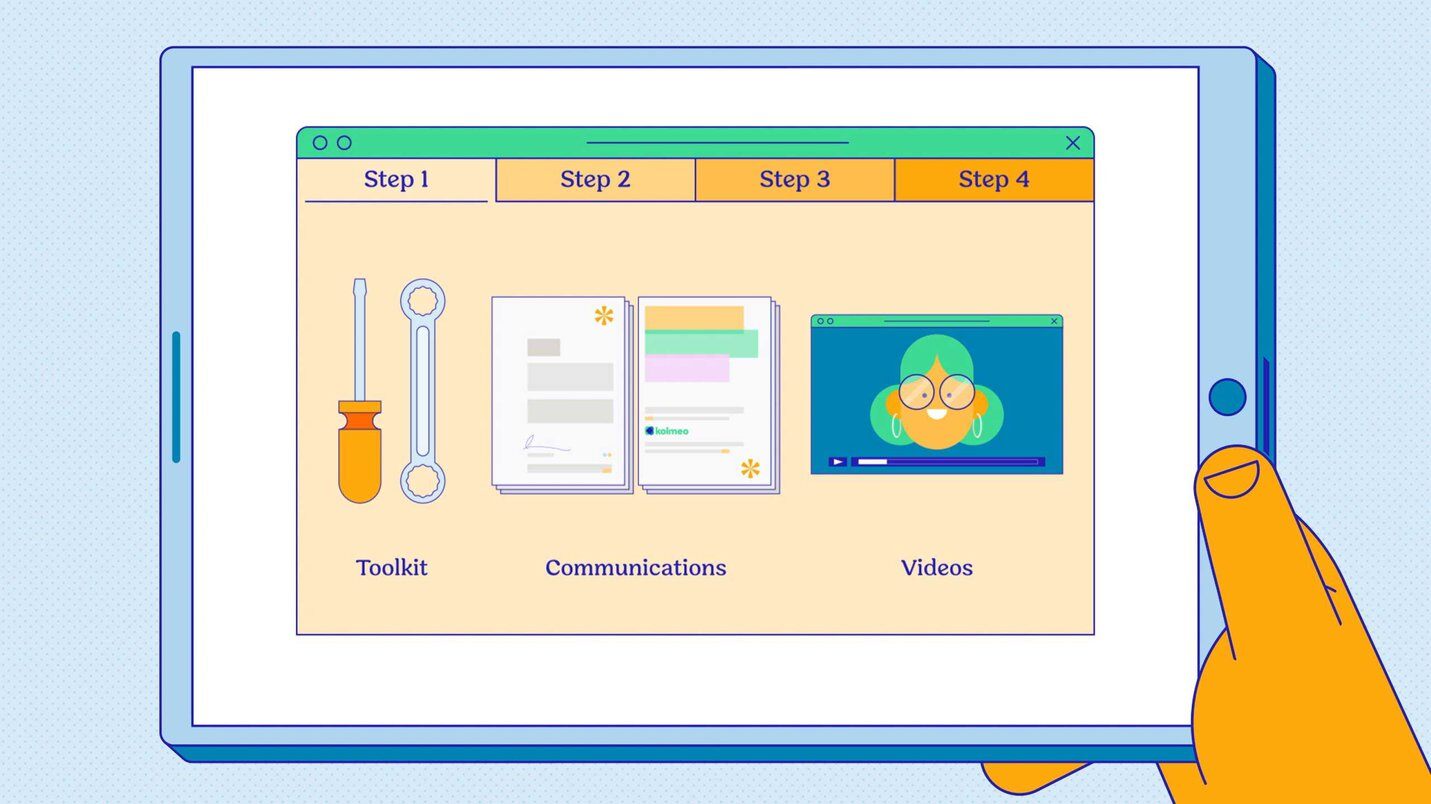
Five factors for an easier migration for property management software
Upgrading to new tech like onto Kolmeo as your new property management software is likely to be one of the biggest change projects your real estate agency will ever take on. But there are ways to make it a less disruptive transition and ensure your business gets the maximum benefit from day one.
In a deep dive into the challenges of moving data along with your people across to a new platform, Kolmeo Customer Success Manager, Briony Maloney, takes us through her tips for getting migration-ready so your business can limit glitches, downtime and errors, and keep your customers and team happy throughout the process.
Getting your migration project started
Briony has been working with Kolmeo customers moving their data, people and operations onto Kolmeo property management software. Together with all Kolmeo Customer Success Managers in our transition team, she’s now taken a number of organisations through the migration process and it’s taught her a lot about the challenges that agencies face without proper preparation, project management and resourcing for a platform migration.
“A successful transition from old to new systems really comes down to effective change management,” she says. “Business leaders need to be aware of the commitment they’re making in terms of time and resources to make a migration easier on everyone – team members, owners and tenants.”
“There are basically three key problems that come up over and over again if a migration project isn’t properly resourced and planned for,” Briony adds. “Things can quickly get out of control if you have a project manager that's pulled in too many directions. Another common problem is poor data preparation. The gaps and double-ups in a data set that hasn’t been cleaned can cause a lot of errors and extra work down the track when you’re up and running on the new system.
“And finally, you need to bring your team along on the journey, explaining why you’re moving across and what’s in it for them. If they can’t see the point of it all, they won’t be engaged enough to get up to speed on the new way of doing things.”
Five factors for an easier migration
Although Briony sees similar problems come up, she’s quick to acknowledge that every migration project is going to be different. “Everything from the systems and technology an agency is currently using to the size of their organisation is going to have an impact on the what’s needed to make a migration work,” she says. “An agency with thousands of properties, hundreds of staff and multiple offices is going to have quite different needs compared with a 200-property business.”
But Briony also reckons there are five key things all agencies can get on top of for a smoother transition from old to new technology, and better outcomes from their migration as a result.
1. Get the timing right
There really aren’t many long spells of downtime in property management. People are forever on the move so it’s tricky to pinpoint the ideal time of year to schedule a migration project. “You definitely wouldn’t do it at over the holiday period,’ says Briony. “In urban areas people are on the move to get into their preferred school zone. Extremely busy times like this are definitely best avoided.”
Timing a migration for just before a new rent period begins is likely to make things easier and Briony suggests allowing a minimum of eight weeks for preparation, migration and getting settled in with a new system. “The actual time you’ll need will depend on the resources you can dedicate to your migration project,” she says. “This estimate is based on having about six weeks to prepare. Up until a week before everything can keep running as business as usual. In the final week you’ll need to put most things on hold so if there are lease renewals and routine inspections that fall in this period, bring them forward.”
“Once everything has moved across you’ll need roughly a two week period when a lot of everyday work will be on hold while everyone has a chance to settle in,” Briony adds.
2. Dust off your data
When you’re communicating about a platform change to property management customers, whether owners or tenants, having the right email is essential. “Mobile numbers are really important too, but for a migration, it’s all about the email,” says Briony. “Email is the go-to channel for sharing instructions about downloading an app and it’s their email address they’ll be using to set up their login.”
This is just one reason why it’s so important for agencies to spend time cleaning their data before a migration. “Check for missing and invalid email addresses as well as bank account information,” says Briony. “On the property side, you’ll find it much easier to get new inspection and listing routines up and running if you’ve taken time to check and verify property attributes too.”
This kind of work is repetitive and it takes time to do it thoroughly. “If your property managers don’t have time to get it done on top of their existing workload, look at outsourcing your data clean-up to a virtual assistant,” says Briony. “This is a smarter way to ramp up the resources you need for migration. Property managers can add far more value guiding owners and tenants through the transition rather than trawling through your database.”
3. Choose your change champion
When it comes to powering through your migration with ease, the internal resource to get right is your change champion. “Choose at least one person to dedicate to this project for the weeks or months it takes,” says Briony. “If you have a larger agency, with multiple offices, you’ll need more than one. And it’s important to make sure their usual responsibilities are taken on by other team members so they don’t get distracted from their two big priorities – keeping everyone informed and moving things forward.”
Choose at least one person to dedicate to this project for the weeks or months it takes.
In deciding who to choose for this role, look for someone who has a positive mindset and isn’t afraid to speak up. “You need someone vocal, who doesn’t get silenced by negativity,” says Briony. “They also need to know your processes and data intimately. Often an operations manager is your ideal change champion, because they’re really savvy about how things work across the whole business.
4. Be process-ready
A technology upgrade can create a better user experience, for customers and your team. Better means faster and more responsive because you’ll be able to roll out streamlined processes for every property management task. But your team and customers won’t be getting the benefit unless you take time to update your processes to work in harmony with what your new tech can do.
“Not having internal processes ready to go can really stop your agency from taking full advantage of a tech upgrade,” says Briony. “From listing a new property to onboarding a tenant, Kolmeo is designed to make all these tasks run more smoothly but only if you take time to figure out how to change what you’re doing now to take advantage of app features. Then you’ll need to train your people to follow the new processes. It helps to get them involved them in process redesign – it’s the ideal way to share the workload and get everyone up to speed on what new technology can do for them.”

5. Communicate again and again
Briony suggests bracing yourself for lots of phone calls from owners and tenants throughout the transition process. “You’ll need to overcommunicate to tenants and owners anyway, but you still need to be prepared for a big uptick in reactive communication,” she says. “One email to tenants and owners is not going to cut it. People are busy and it will take several communications for them to understand what the change means for them. So keep sharing information in different forms and follow up with phone calls as needed.”
Although a change might seem relatively simple, tenants and owners can both have concerns about how and when rent will be paid. “If your migration involves changes in payment arrangements, this takes really careful communication,” Briony adds. “If payment intervals are changing or you’re moving to different payment methods, that can make tenants anxious. You need to allow for this in how you communicate so that the change doesn't have unintended outcomes like tenants falling into arrears because of poor communication.”
Making the move Kolmeo style
This migration checklist might seem like a lot to take on while keeping up with business as usual. At Kolmeo, we know this and do all we can to lighten the load on your resources.
“You get a dedicated Customer Success Manager to step you through this checklist of tasks,” says Briony. “They’ll work with you on a project plan and own it, checking in regularly to see what’s happening and to offer advice on anything you’re struggling with. All our team have worked as property managers so we really get what agency teams are up against and can offer insights and advice that are realistic.”
“We also use amazing internal systems and technology to manage our own workload,” Briony adds. “So you’re learning a new way of working from busy people who lean on good technology to be more productive. You’ll also have access to a data team dedicated to migration. We run reports for you and guide you through acting on these to get all your property, owner and tenant data in the best shape for migration. Plus we’ll give you pro forma communications to share with your team, tenants and owners. Just add your own branding and you’ll be all set to share important migration messages with all stakeholders.”
Kolmeo also offers training resources including webinars and our customers have access to the Kolmeo Help Centre to tap into the knowledge base provided by our team.
For any agencies out there thinking about a migration, Briony reckons all the hard work is well and truly worth it. “Migrations can feel like they go on forever,’ she says. “But when it’s all done and dusted, you’re going to be ok. In fact, you’ll be better than ok because you’re making an investment in a much more cost-effective business that’s also much more engaging, for your team and your customers.”


